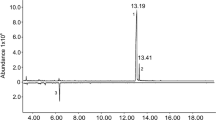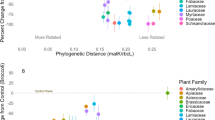Abstract
MASS aggregations of populations of Dendroctonus (Scolytidae) on new host trees are largely caused by olfactory responses to attractants created by the attacking females1,2. The attractant is apparently composed of host and insect components which interact in some unknown manner in orienting the population to new hosts. In our experiments with Dendroctonus brevicomis Lec. in California, D. ponderosae Hopk. in Idaho, and D. frontalis Zimm. in Texas, mass aggregation could not be induced by either host or insect factors when tested independently. These results are contrasted with those obtained with another group of scolytids (certain Ips) where faecal matter per se from mature males was highly attractive3,4. In both groups of bark beetles, however, the mechanism of pheromone release is defaecation and the probable sites of elaboration and concentration are the Malpighian tubes and hindgut area5,6.
This is a preview of subscription content, access via your institution
Access options
Subscribe to this journal
Receive 51 print issues and online access
$199.00 per year
only $3.90 per issue
Buy this article
- Purchase on Springer Link
- Instant access to full article PDF
Prices may be subject to local taxes which are calculated during checkout
Similar content being viewed by others
References
Vité, J. P., and Gara, R. I., Contrib. Boyce Thompson Inst., 21, 175 (1961).
Gara, R. I., Vité, J. P., and Cramer, H. H., Contrib. Boyce Thompson Inst., 23, 55 (1965).
Vité, J. P., Gara, R. I., and Kliefoth, R. A., Contrib. Boyce Thompson Inst., 22, 39 (1963).
Pitman, G. B., Renwick, J. A. A., and Vité, J. P., Contrib. Boyce Thompson Inst., 23, 243 (1966).
Pitman, G. B., Kliefoth, R. A., and Vité, J. P., Contrib. Boyce Thompson Inst., 23, 13 (1965).
Zethner-Møller, O., and Rudinsky, J. A., Ann. Entomol. Soc. Amer., 60, 575 (1967).
Renwick, J. A. A., Contrib. Boyce Thompson Inst., 23, 355 (1967).
Moore, R. M., Golumbic, C., and Fisher, G. S., J. Amer. Chem. Soc., 78, 1173 (1956).
Pitman, G. B., and Schönherr, J., Contrib. Boyce Thompson Inst. (in the press).
Vité, J. P., Gara, R. I., and von Scheller, H. D., Contrib. Boyce Thompson Inst., 22, 461 (1964).
Kangas, E., Perttunen, V., Oksansen, H., and Rinne, M., Acta Entomologica Fennica, 22, 1 (1967).
Silverstein, R. M., Rodin, J. O., and Wood, D. L., Science, 154, 509 (1966).
Author information
Authors and Affiliations
Rights and permissions
About this article
Cite this article
PITMAN, G., VITÉ, J., KINZER, G. et al. Bark Beetle Attractants: Trans-verbenol isolated from Dendroctonus. Nature 218, 168–169 (1968). https://doi.org/10.1038/218168a0
Received:
Issue Date:
DOI: https://doi.org/10.1038/218168a0
This article is cited by
-
Effect of Environmental Conditions on Flight Capacity in Mountain Pine Beetle (Coleoptera: Curculionidae: Scolytinae)
Journal of Insect Behavior (2020)
-
The cytochrome P450 CYP6DE1 catalyzes the conversion of α-pinene into the mountain pine beetle aggregation pheromone trans-verbenol
Scientific Reports (2019)
-
Comparative transcriptomics of mountain pine beetle pheromone-biosynthetic tissues and functional analysis of CYP6DE3
BMC Genomics (2017)
-
Bioconversion of α-pinene by a novel cold-adapted fungus Chrysosporium pannorum
Journal of Industrial Microbiology and Biotechnology (2015)
-
Pheromone Production by an Invasive Bark Beetle Varies with Monoterpene Composition of its Naïve Host
Journal of Chemical Ecology (2015)
Comments
By submitting a comment you agree to abide by our Terms and Community Guidelines. If you find something abusive or that does not comply with our terms or guidelines please flag it as inappropriate.



